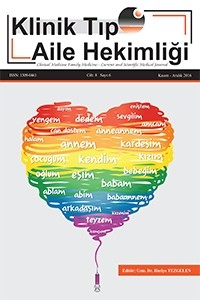Tekrarlayan İdrar Yolu Enfeksiyonu Olan Çocuklarda Renal Skar Tespiti İçin Görüntüleme Yöntemlerinin Karşılaştırılması
ÖzGiriş:İdrar yolu enfeksiyonu 2 yaş altı çocuklarda ateş, bakteriyemi, sepsis ve organ yetmezliğinin sık ve önemli bir nedenidir. Tekrarlayan idrar yolu enfeksiyonunda mortalite ve morbiditeye neden olabilen üst üriner sistem enfeksiyonları, akut ve kronik renal yetersizliğin önlenebilmesi için risk faktörleri, tanı ve tedavi algoritmaları belirlenmelidir.Yöntem: Ocak 2005–Ocak 2010 tarihleri arasında hastanemizin Çocuk Nefroloji polikliniğindetekrarlayan idrar yolu enfeksiyonu tanısı ile izlenen 101 hasta retrospektif olarak değerlendirildi. Bu hastaların tam idrar tetkiki, idrar kültürü, üriner sistem ultrasonografisi (USG),voiding sistoüreterogram (VCUG) ve Tc-99m DMSA sintigrafi sonuçları kaydedildi.Bulgular: 101 olgunun %78.2’ si kız, %21.8’i erkek, %23.8 olguda USG’de renal parankimalhasar, %38.6 olguda VCUG’de reflü, %70.3 olguda DMSA sintigrafisinde skar ve ak-tivite kaybı tespit edilmiştir.Sonuç: VUR insidansı ve derecesi arttıkça renal skar sıklığının arttığı, VUR ile renal skararasında pozitif korelasyon olduğu tespit edilmiştir. Ayrıca tekrarlayan idrar yolu enfek-siyonu olan vakalarda renal hasarı göstermede en duyarlı görüntüleme yönteminin re-nal sintigrafi olduğu saptanmıştır.
Anahtar Kelimeler:
Tekrarlayan idrar yolu enfeksiyonu, vesikoüreteralreflü, renal skar
Comparison of Imaging Techniques in Detecting Renal Scars in Children with Recurrent Urinary Tract Infections
AbstractIntroduction Urinary tract infections (UTIs) are a frequent and important cause of fever, bacteremia, sepsis, and organ failure inchildren under two years of age. Severe infections that cause mortality and morbidity in recurrent urinary tract infections, risk factors, diagnosis, and treatment for the prevention of acute and chronic renal insufficiency should be well known.Methods: Between January 2005 and January 2010, a total of 101patients with recurrent urinary tract infection were evaluated retrospectively in the pediatric nephrology clinic of ourinstitution. Patient data were obtained retrospectively fromcharts in the hospital archives. The age, gender, demographics, physical examination findings, laboratory results, andimaging data were recorded.Results In a total of 101 cases, 78.2% of them were female, and21.8% of them were males. Renal parenchymal damage wasdetected in 23.8% of the cases using ultrasonography(USG), vesicoureteral reflux (VUR) was detected in 38.6%of the cases using voiding cystourethrography (VCUG),andrenal scars and activity loss was detected in 70.3% of thecases using Tc-99m dimercaptosuccinic acid (DMSA)scintigraphy.Conclusion It was determined that, as the incidence and the degreeof VUR increase, the frequency of renal scar increases; andthere is a positive correlation between VUR and renal scars.In addition, renal scintigraphy was the most sensitive ima-ging method in cases of recurrent urinary tract infections.
___
- Kaynaklar 1-Shaw KN, Gorelick M, McGowan KL. Prevalence of urinarytract infection in febrile young children in the emergency de-partment. Pediatrics 1998;102(2):e16. 2-Bensman A, Durand O, Ulnski T, Avner E, Harmon W, Niaudet P, et al. Urinary Track Infections. Pediatric Nephrology.6th ed. Berlin: Springer; 2009.P.1299-11 3-Melhem RE, Harpen MD. Ethnic factors in the variability of primaryvesico-ureteral reflux with age. Pediatr Radiol 1997;27(9):750-1. 4-Cooper CS, Austin JC. Vesicoureteral reflux: who benefits fromsurgery? Urol Clin North Am 2004;31(3):535-41. 5-Jaksic E, Bogdanovic R, Artiko V. Diagnostic role of initial re-nal cortical scintigraphy in children with the first episode ofacute pyelonephritis. Ann Nucl Med 2011; 25(1):37-43. 6-Spencer DJ, Schwaderer A, McHugh K. Pediatric urinary tractinfections: an analysis of hospitalizations, charges, and costsin the USA. Pediatr Nephrol 2010; 25(12):2469-75. 7-Piepsz A, Colarinha P, Gordon I. Paediatric Committee of theEuropean Association of Nuclear Medicine. Guidelines for99mTcDMSA scintigraphy in children. Eur J Nucl Med2001;28(03): BP37–BP41 8-Roberts KB. University Of North Carolina School Of Medi-cine, Chapel Hill, North Carolina Am Fam Physician. 2012Nov 15;86(10):940-946. 9-Soylu A, Demir BK, Türkmen M. Predictors of renal scar inchildren with urinary infection and vesicoureteral reflux. Pe-diatr Nephrol 2008;23(12):2227–2232 10-Roupakias S, Sinopidis X, Tsikopoulos G, Spyridakis I, Karat-za A, Varvarigou A. Dimercaptosuccinic acid scan challengesin childhood urinary tract infection, vesicoureteral reflux andrenal scarring investigation and management.. Minerva UrolNefrol 2017;69(02):144–152 11-Ayazi P, Mahyar A, Daneshi MM. Diagnostic accuracy of thequantitative c-reactive protein, erythrocyte sedimentation rateand white blood cell count in urinary tract ınfections among ın-fants and children. Malays J Med Sci 2013;20(5):40-6. 12-Gelfand MJ, Koch BL, Elgazzar AH. Cyclic Cystography: Di-agnostic yield in selected pediatric populations. Radiology1999; 213(1):118-20. 13-Mahyar A, Ayazi P, Mavadati S. Are clinical, laboratory, andımaging markers suitable predictors of vesicoureteral refluxin children with their first febrile urinary tract ınfection? Ko-rean J Urol 2014;55(8):536-41. 14-Sciagrà R, Materassi M, Rossi V. Alternative approaches tothe prognostic stratification of mild to moderate primary ve-sicoureteral reflux in children. J Urol 1996; 155(6):2052-6 15-Askari A, Belman AB. Vesicoureteral reflux in black girls. JUrol 1982; 127(4):747-8 16-Caione P, Ciofetta G, Collura G. Renal damage in vesico-ure-teric reflux. BJU Int 2004; 93(4):591-5 17-Lee JH, Son CH, Lee MS. Vesicoureteral reflux increases therisk of renal scars: a study of unilateral reflux. Pediatr Neph-rol 2006; 21(9):1281-4. 18-Peru H, Bakkaloğlu SA, Söylemezoğlu O. The relationship bet-ween urinary tract infections and vesicoureteral reflux in Tur-kish children. Int Urol Nephrol 2009; 41(4):947-51. 19-Bush NC, Keays M, Adams C. Renal damage detected byDMSA, despite normal renal ultrasound, in children with feb-rile UTI. J Pediatr Urol 2015; 11(3):126.e1-7 20-Roebock DJ, Howard RG, Metreweli C. How sensitive is ult-rasound in the detection of renal scars? Br J Radiol 1999;72(856):345-8. 21-Sahin O, Tasbent FE . Comparison of DMSA Scintigraphy andUSG in Detecting Renal Cortical Scars in Children with Uri-nary Tract Infection. J Pediatr Infect Dis 2018;13:210–215.
- ISSN: 1309-0461
- Başlangıç: 2009
- Yayıncı: Selen Medya Yayıncılık Tanıtım ve Organizasyon Hizmetleri
